Theatrhythm Final Bar Line Review on PS4
Excellent soundtracks have been at the heart of the Final Fantasy series since its inception in 1986. Whether your first foray into the series was the NES original, Final Fantasy VII, or even Final Fantasy XV, chances are good that the music left a memorable impression on you. The compositions produced by the likes of Nobuo Uematsu, Masashi Hamauzu, Yoko Shimomura, and many others have stood the test of time, cementing themselves as a fundamental aspect of the series and even enduring outside of it in various forms.
Enter Theatrhythm Final Bar Line, the latest release of the rhythm game series. It allows the player to form a custom party from a vast pool of Final Fantasy characters in order to tap, hold, and swipe to the beat of hundreds of songs from the series at large. It’s a sizable sum of content, certainly, but is there enough mechanical depth to encourage the player to see it all?
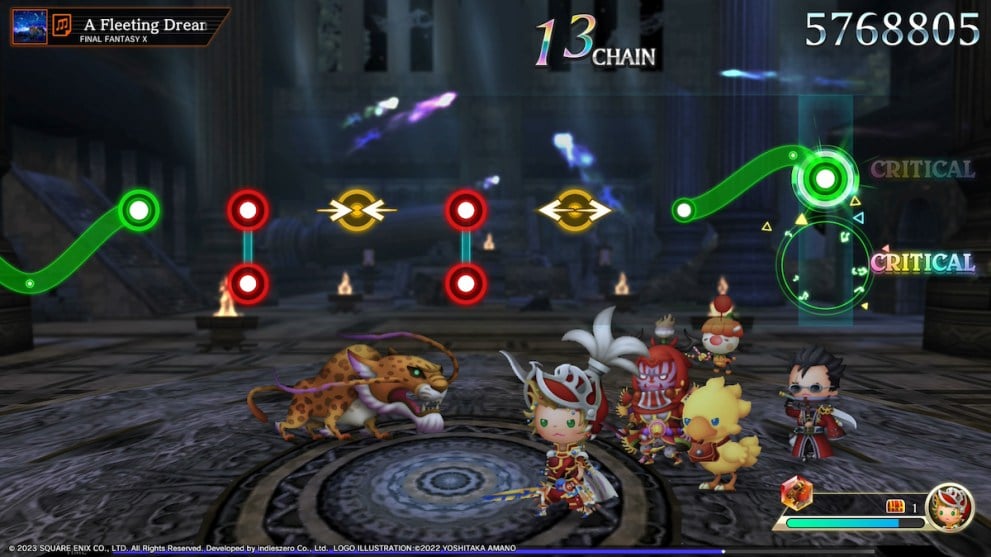
Any great rhythm game requires an equally great soundtrack, and if the above introduction wasn’t enough to drive this point home, the selection of playable songs here is excellent. Final Bar Line is divvied up into submenus—one for each Final Fantasy game—that you work through. Playing each song to completion nets the player experience and the ability to progress to the next, and this general loop is what you can expect from the game as a whole.
Each song falls under one of three categories (Field Music, Battle Music, or Event Music), but all of them play out more similarly than not, requiring the player to tap or hold up to two buttons at a time and flick the analog sticks according to the scrolling button prompts. Each button prompt is easy to handle individually, but the way each track combines them and asks the player to switch between different inputs is where the challenge lies.
One of the core tenets of rhythm gaming has always been that feeling of personal progression as your skill improves and you begin to better understand the systems at play, and Theatrhythm Final Bar Line provides quite a bit to chew on in this regard. Each tier of difficulty sports a significant increase in challenge and the level of execution required from the player.
It can feel so significant, in fact, that the jump between one tier and the next can seem like quite the mountain to climb. However, rather than being prohibitive to your sense of progression, tracks are balanced in such a way that eventually reaching a new difficulty tier is highly satisfying and easy to work toward.
And this all is to say nothing of the RPG elements on offer.
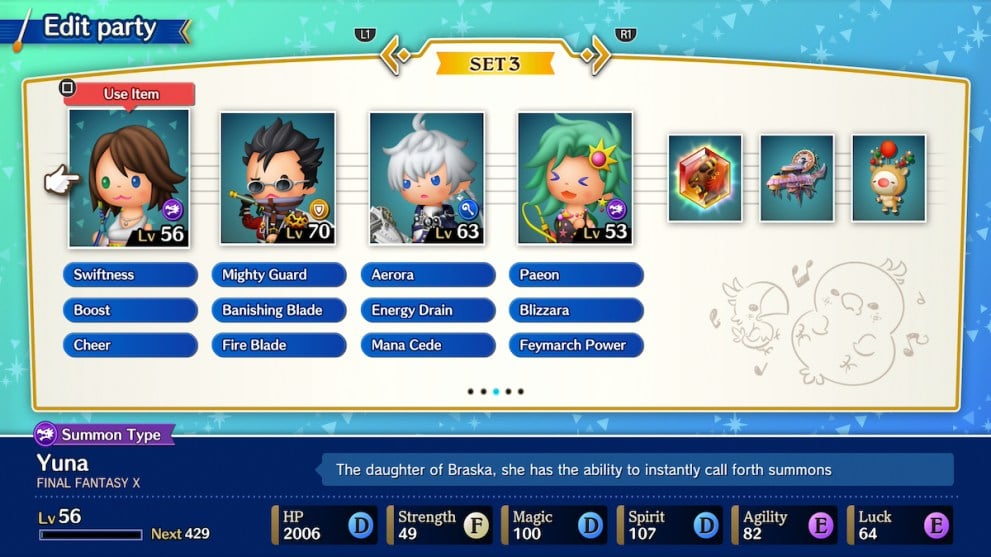
As stated above, the game lets you create parties of four Final Fantasy heroes and villains to combat a stage’s baddies. As you complete songs, your chosen characters will earn experience, level up, and earn passive skills that activate under certain conditions during gameplay. Each character can equip up to three of these at once, and they ended up being far more effective than I was expecting.
Case in point: Vanille from Final Fantasy XIII. One of her unique skills automatically grants a full heal after falling below 10% HP, essentially allowing you two attempts at a song rather than one, which is godsend for eking out that last stretch of notation you’re having trouble with.
Final Fantasy II’s Minwu also has a powerful buff and regen effect that kicks in only at the halfway point of a song (which is typically when things get more challenging) thus lessening the impact of your mistakes. Debuffs are also considerably potent, with a successful infliction of blindness causing you to take no damage from enemies no matter how many mistakes you make.
Customizing your team and striving for the perfect composition for a given track is mostly facilitated by the quest system. Each song tasks the player with an additional objective, which can range from finishing the piece with a certain element to bringing along a specific character.
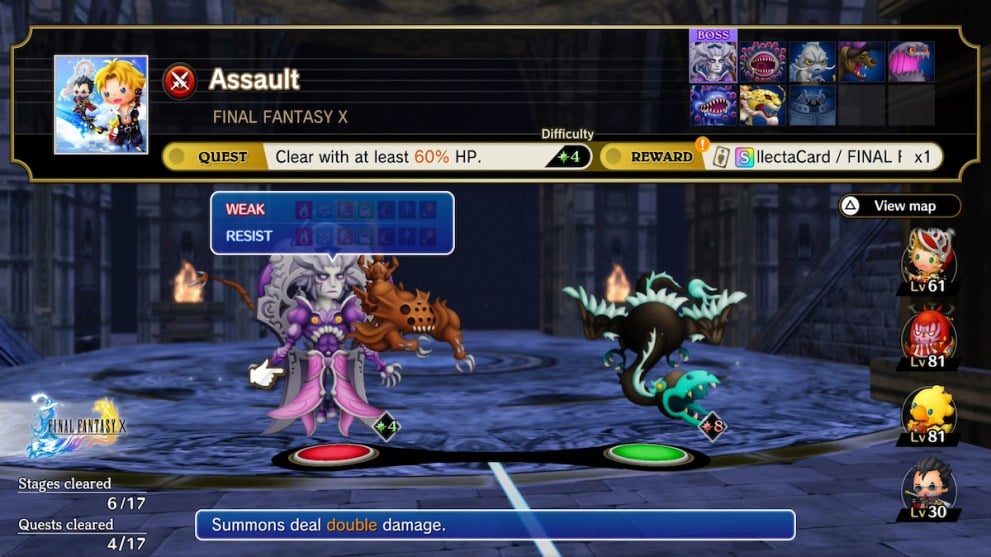
Crucially, the door is still left open for those that don’t want to bother with party management and the like. The quest system is largely optional should you want it to be, and you’re able to automatically outfit your party with an optimal configuration at the press of a button.
Not everything about Final Bar Line can be discussed so glowingly, though. Particularly in the earlier parts of the game, for every song quest you can complete on your first go-round, you’ll find another that simply isn’t feasible with your current level or unlocked abilities.
There’s nothing preventing you from returning after you’ve gained the requisite strength, but you have to go into a particular game’s submenu to see if it has any incomplete quests, and having one place to see all quests would have been helpful for completion’s sake.
The omission of several iconic songs from the standard edition, such as Eyes On Me from Final Fantasy VIII and Final Fantasy X’s To Zanarkand, is glaring. It simply doesn’t feel right that main themes like these are locked behind the Deluxe Edition paywall, and it’s a shame.
Additionally, there’s no compensation of any kind of failing a song, be it experience, items, or otherwise. This can make enhancing low-level characters (who lack the skills to assist with higher difficulties) more of a chore than it needs to be.
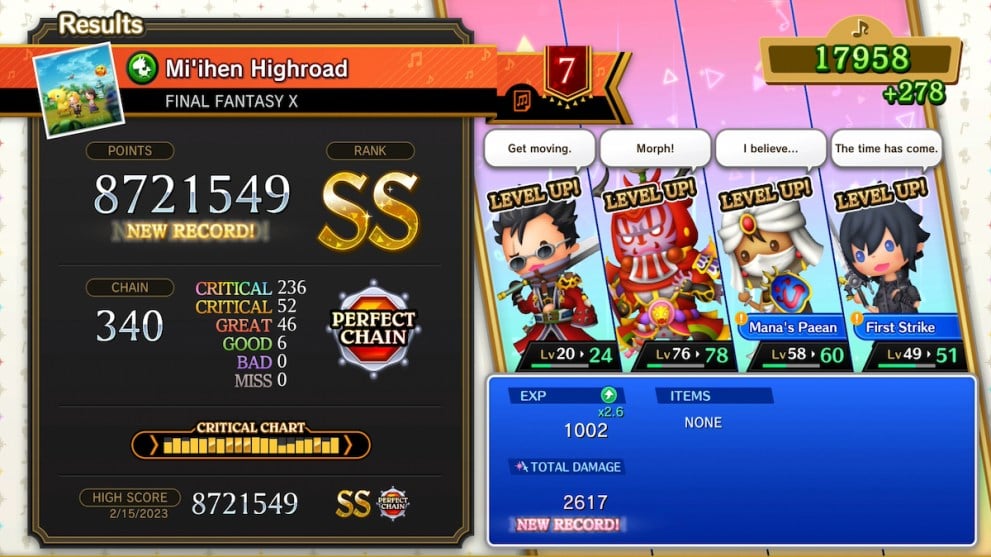
On the artistic front, Theatrhythm has always had something of a hill to climb thanks to its premise; it’s all about teaming up characters and enemies from a wide array of games released across a span of 35 years, many of which sport disparate art styles.
To combat aesthetic clashing, the characters in Theatrhythm Final Bar line have all been adapted into softer, more cartoonish iterations with similar features. Giving everyone a more universal appearance is a necessary evil for visual cohesion, but it can feel as though some character has been lost in the transition. Still, it works more than it doesn’t, and the party members suffer from it more than the enemies, summons, or bosses do, but it’s all adorable regardless.
There’s also little fault to be found in the extensive background assets and the way they recreate notable locations relevant for each song to provide extra emotional oomph. A few of them can make it a bit more difficult to see upcoming button prompts (particularly those with a lot of motion and pulsing coloration), but thankfully they’re few and far between.
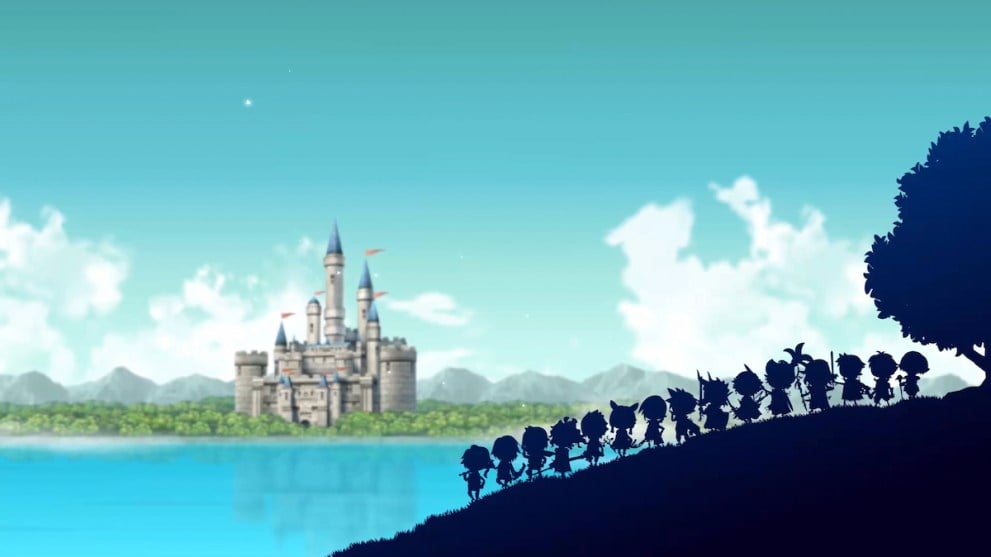
Many a Final Fantasy game can be described as a journey, and Theatrhythm Final Bar Line is much the same. It’s a content-rich rhythm game that distills and celebrates the music of the series’ entire span, from the mainline to the spin-offs and everything in between.
More than that, it pays mechanical homage by providing tangible RPG elements that complement the rhythm game portions without overwhelming them. When you pair this with a sizable amount of high quality tunes and room for mechanical improvement for the player, Theatrhythm Final Bar Line has a lot to give rhythm game fans and Final Fantasy fans alike.
Pros
Cons
No XP for losses makes it annoying to level up low level characters
